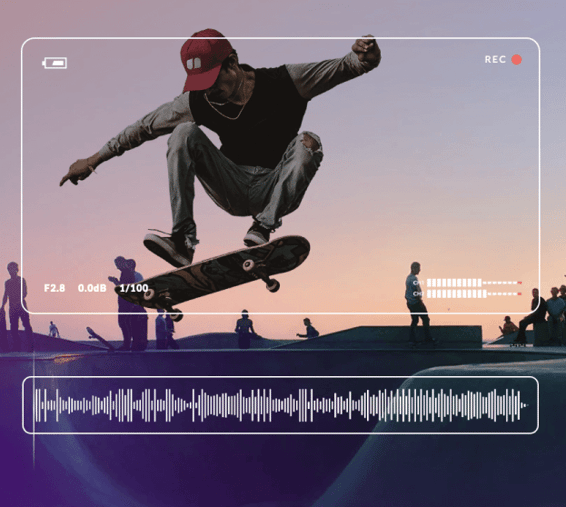Welcome to Outstanding
Music for Films






Listen to our Best Music for Films
We know the right song can make or break your project. That’s why every track in our library is vetted by award-winning producers. Hear for yourself. We've curated a playlist with our best music for films.
Looking for something different?
We got you. From classical to hip hop to indie, our audio library contains thousands of outstanding tracks. Use one of our 13 filters or check out other curated playlists to find what you need in minutes.
BROWSE THE FULL CATALOG
Dead Simple Licensing
Never worry about sync licensing again. With Soundstripe, your membership covers the cost for every song license. Just find the right track, download the file, and get a custom license. That’s it. No channel or media-specific fees, no recurring royalties, ever. Here’s more good news: you have unlimited licenses. Go ahead, download as many songs as you want.
How to Use Music in Films
There is a reason why musicians and composers receive high praise and accolades for film soundtracks. These creators are well-versed in the sound production process and recognize that music moves narratives forward.
While a film’s visual elements impact the overall viewing experience, music strengthens these visuals by evoking emotional responses from the audience.
This is seen time and time again in montage short films. Dialogue is minimal, if present at all, yet the audience is captivated by the narrative and moved by the musical composition.
Whether working on a small or large-scale production, creators shouldn’t underestimate the importance of music selection. Though visual cues like body language are important, music has the ability to change the audience’s interpretation of a scene.
For instance, if somber music accompanies a wedding scene, the message communicated to the audience isn’t one of bliss and eternal love. Even if all of the visual cues suggest otherwise, viewers interpret the scene differently because of music selection.
Filmmakers are aware of how music influences perception, which is why they devote so much time to the production and post-production process. Every decision — whether creative, financial, or otherwise — is thoughtfully considered and logistically sound.
The right musical accompaniment enhances the action-packed, tragic, and comedic scenes in any film project. When creating impactful films, finding the best music for the occasion is crucial but can also be expensive.
This guide offers tips on how you can diversify your film’s soundtrack with affordable, high quality music that will evoke deeper emotional responses from the audience and allow you to stay within budget.
The Psychology Behind Music in Film
Years after watching a film, our brains recognize music from the soundtrack when we hear it again. Though we may not be able to recall specific scenes or the name of the film, the sound is instantly familiar to us.
There’s a reason why we get goosebumps when listening to music. Music engages different areas of the brain and manifests as physical responses. While the left side of the brain controls language, music activates both sides of the brain.
When music triggers emotional and physical responses, the sounds become part of the brain’s musical memory. This is possible because music is processed by the brain’s hippocampus — which is responsible for activating learning and memory.
By analyzing brain imaging, researchers have found that music activates areas of the brain not damaged by Alzheimer’s disease and other forms of dementia. One study found that when Alzheimer’s patients listened to songs that held personal value, the functional MRI revealed higher levels of brain activity.
When treating dementia patients, another study found that music interventions positively impact mood and reduce agitation. The findings from both studies reveal how music can positively impact and improve health, anxiety, and memory on a psychological level.
With all things considered, you shouldn’t underestimate the significance of music selection in your films.
When music is paired with a particular scene, viewers respond based on how the two elements work together. In the same way that music affected the patients’ mood in the second study, the music in films influences viewers’ emotional responses.
Memorable Uses of Music In Film
As a filmmaker, you’re conscious of the way music and sound selections impact your ability to tell a powerful story.
In preparation for your next production, it can be rewarding to analyze other films’ soundtracks and consider the effects of music scores, sound effects (or SFX), and songs on the viewers’ experience.
As seen in the following films, music strengthens the emotional impact of a scene and enhances the overall viewing experience.
1. The Holiday
Throughout The Holiday — and this scene in particular — the music score reflects not only the mood of the moment but the personalities of the characters. As Iris (Kate Winslet) and Miles (Jack Black) suggest, a certain melody has the ability to sound like a certain person.
Though the film’s score is composed off-screen, this scene is meta in the sense that Miles is portrayed as the composer for part of the film’s actual score. Arthur’s theme song is “composed” on-screen by Miles with the intent of empowering and inspiring confidence in another character.
Not to mention, this scene includes a clever callout to John Williams’ famous score from the Jurassic Park series.
2. Jurassic Park
This particular scene uses a combination of the music score and SFX to intensify the audience’s sense of desperation and distress. The stakes are high for the characters’ survival, and the music and sound selection makes the situation seem even more dire.
This is an instance where the visual and auditory cues align to enhance the feeling of imminent danger. SFX allows viewers to perceive the raptors as more believable and daunting on-screen, and the music intensifies as the characters attempt to evade death.
3. Star Wars
This scene from Star Wars: The Empire Strikes Back (1980) begins with a confrontation between Darth Vader and Luke Skywalker, and SFX is exclusively used here. Toward the end of the scene, the famous music score gradually joins the SFX to amplify the conflict.
The music and SFX build up the intensity of the scene as the two characters duel and Luke Skywalker is slowly overpowered.
Integrating Music During Post-Production
What Filmmakers (Legally) Need-to-Know
1. The Music Licensing Process
Before you can develop a film’s soundtrack, you need to understand the legalities behind using music for movies.
There are many stems to the music licensing process, and with good reason.
Creators copyright their work to ensure that it is fully protected from misuse by others. Copyrights function as a safeguard for you and also the teams that collaborate to produce the lyrics and sound recording.
The licensing process is airtight, but not always straightforward.
While it’s necessary to have a licensing protocol in place, the process can also complicate production by making it more difficult to secure the right permissions to use music in film.
More often than not, filmmakers need three main licenses to integrate copyrighted music into their project. These licenses are the synchronization license, master license, and print license.
Let’s break down why these licenses are important for filmmakers.
Synchronization, Master, and Print Licenses
To start, synchronization licenses grant creators the ability to edit music and visual media together. The sync license is popular among creators because songs can be re-recorded unless the licensing agreement specifies otherwise.
This license is similar but not identical to the master license. While a master license is just as necessary for filmmaking purposes, it offers less flexibility when it comes to how the music can be used.
Master licenses allow you to use the master recording of a song in film projects, but don’t give you the right to re-record the music. In a sense, this is a take-it-as-you-get-it type of license.
The third main license that you’ll need for a film project is the print license. It’s important to acquire this type of license if you need the sheet music to reproduce a certain song. Though it may be possible to find copies of the sheet music on the internet, you can’t legally use the music without a print license.
While there are other types of music licensing, these three are the ones that every filmmaker needs to know about. Whether you use a ten second sound bite or the entire song, the licenses you need are the same.
It’s important to secure the proper licenses before production starts to avoid any legal roadblocks.
2. The Benefits of Royalty-Free Music
Music licensing is not as simple as earning one creator’s approval. Because several creators come together to produce the lyrics and sound recording, each one has to grant you permission to use their work.
Acquiring the rights to a single song can take weeks or longer, depending on how many people own the rights to the song. There isn’t a set time window for getting approval, which leads to complications when you’re licensing multiple songs at the same time.
You can simplify this process by using royalty free music for filmmakers.
With a stock music library, the music licensing negotiations are handled for you. A subscription to a company like Soundstripe gives you access to thousands of radio-quality songs with a single search.
So if you need somber music for that wedding scene, you can easily filter through the options until you find the song that resonates the most with you.
3. The Importance of Cue Sheets
Let’s say you have a subscription with a stock music library. Though you have full access to the music and can license any song, being able to legally use music for a film or TV program requires a couple more steps.
Anytime you outsource music from stock libraries or other creators, it’s important to submit cue sheets for approval. Without a cue sheet submission — and permission from the company or creator — you aren’t legally cleared to release your film in theaters or on TV.
While the music licensing process is time-consuming and complex, the process for completing a cue sheet is extremely simple. Formatting can vary, but the elements remain the same across the board.
First, you’ll list the film’s title, length, and release date as well as the production company’s contact information. When using multiple tracks in your film, you need to log each one and include whether part or all of the track will be featured.
Once a cue sheet is accepted, you can start integrating the music into your film’s soundtrack.
Curating A Film’s Soundtrack
When developing and organizing a film’s soundtrack, you can adapt your shot list to account for the music you plan to include. This allows you to visualize how the scenes will pair with the music prior to filming.
By aligning music with video ahead of time, you can also notice if there are any gaps that need to be filled with music.
Especially when pressed to meet a deadline, the last thing you want is to discover that something is missing toward the end of post-production. This leaves you with little to no time to find new songs, let alone receive permission to use the songs.
The sooner you recognize these issues, the sooner you can correct them.
In this guide so far, we’ve discussed how filmmakers legally use copyrighted and uncopyrighted (or royalty-free) music in films. While outsourced music is part of a film’s soundtrack, the soundtrack also includes the original score and SFX.
The Music Score
A defining feature of every film is the music score.
This is because the score is an original musical composition that musicians and composers develop for a specific film project. Because music scores are original, audiences can quickly identify music scores from films they’re familiar with.
Take the films Jaws (1975) and Jurassic Park (1993), for example. People who have seen the films in the past can differentiate one film score from the other because the music scores are distinctive.
While music scores for blockbuster films may be widely recognized, the scores in smaller productions are just as memorable.
SFX
Oftentimes, you will either hire foley artists to produce original SFX or outsource SFX from stock libraries.
The process for using SFX is nearly identical to the process for using outsourced music. Both SFX and music are integrated into a film’s timeline during post-production to enhance the sound quality and impact of the film.
With a subscription to a stock library, you can conveniently access and license SFX and music in one place. This allows you to bypass the complex music licensing process and focus instead on finding the best sounds for your film.
SFX benefits creators by simulating natural sounds such as footsteps, keyboard typing, and laughing. So if the audio captured during production is muffled and unclear, SFX can rescue the scene by giving you the ability to integrate voiceovers and other sounds into the film instead.
The Best Music For Your Film’s Soundtrack
Whether producing a short or feature-length film, you strategically select and integrate music into film because you understand that sounds influence perception.
Musical accompaniments add emotional depth to the visuals in film and enhance the viewing experience. In order to create a memorable final product, you should diversify your search for the best music that will carry the narrative from scene-to-scene.
Over the course of the editing process, RAW footage is transformed into cinematic scenes and audio files become integral parts of the film’s soundtrack. Music selection is pivotal when creating a memorable final product.
An effective way to license music without hassle is to access music through stock music libraries like Soundstripe. Soundstripe provides creators with access to an ever-growing library of stock video, music, and SFX.


Have questions? Give us a call
855.224.0847
Soundstripe - Unlimited Music for Video
© 2017-2020 A Product of Soundstripe, Inc
Nashville TN



